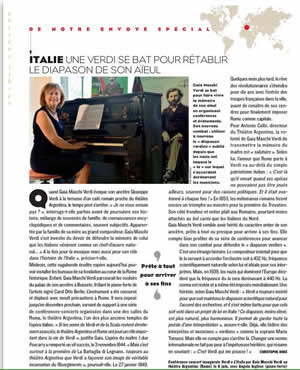Interview with Gaia Maschi Verdi on “Verdi and Italy”
and Verdi Tuning
By Liliana Gorini
June 2016
Photo courtesy of Gaia Maschi Verdi
Gaia Maschi Verdi with the pianist at Verdi's own piano. |
On June 6th 2016, Dr. Gaia Maschi Verdi, medical doctor, journalist and great-grandniece of Giuseppe Verdi, held a very interesting conference-concert at the Teatro Argentina in Rome, during which she presented to the audience the Carol Otto Berlin piano belonging to Verdi, at the time he lived in Palazzo Orlandi in Busseto and composed Rigoletto, Trovatore and Traviata. The piano is tuned to A=432 Hz, the scientific tuning recommended by the great Italian composer in 1884 to the entire music world. Liliana Gorini, chairwoman of Movisol and coordinator of the Schiller Institute campaign for the scientific pitch since 1988, interviewed her for us.
Gorini: First of all congratulations on your important initiative at Teatro Argentina in Rome, reviving the debate on the “Verdi pitch” (A=432 Hz), which was expressly demanded by Giuseppe Verdi in his by now famous letter on 1884. Has the Carol Otto Berlin piano which belonged to Verdi in Palazzo Orlandi been tuned to A=432 Hz since he played on it, or was it tuned later on? It would have great historical relevance; since it confirms Verdi’s commitment to what he himself called “scientific tuning”.
Gaia Verdi: The piano belongs to our family since Verdi sold the palace in Busseto in 1888 to the Orlando family. From my great-grandfather to me, it never changed tuning. It was tuned to A=432 Hz since then. I remember that when my mother, Rosanna Orlandi Barezzi, played it at home, we children would sit around her and listen. She assigned me the task of preserving it, and recommended to me never to change the original tuning.
Gorini: How did your interest for the scientific pitch start?
Gaia Verdi: As a medical doctor I exercise my profession through scientific research. I have been in touch with many researchers who studied the issue of sound vibrations on organs. One of them is Prof. Amedeo Maffei. I got interested in the scientific pitch because it coincides with the vibration of the DNA helix, with the balance of the chakra of the heart, the vibration of the universe as well as Pythagoras’s principles. After a research on Verdi’s spirituality when he was a kid and a teenager, his initiation to music at the organ of the San Michele Arcangelo church in Roncole, and through some priests, I saw in this Golden Tuning supported by Giuseppe Verdi a common thread between science and spirituality in his development, towards a genius of music who anticipated times. Leonardo da Vinci did the same for painting, maybe at their times they read books which never arrived to us.
 View larger size View larger size Gaia Maschi Verdi interview in Le Figaro (French). |
Go to article Coverage of the Le Figaro interview in ForumOpera.com (French) |
|
 Left to right: Piero Cappuccilli, Carlo Bergonzi, interviewer Liliana Gorini and Lyndon LaRouche in November 1997, at a Schiller Institute event in the Salone Barezzi di Busseto. |
||
Gorini: In your interview to Le Figaro you rightly emphasize that despite Verdi’s precise indications, in 1939 the A=440 tuning was adopted, also as a result of the pressures of military bands during the Nazi period. Since this is an arbitrary pitch, through the years, it changed with each opera house, from A=440 in most American opera houses, to A=448 in Berlin, Florence and Salzburg, as Pavarotti and Bergonzi told me, and this ruined not only the voices of opera singers, but also the interpretation of Verdi’s operas. What do you think is the cause for this lack of understanding of the importance of scientific tuning?
Gaia Verdi: I was very shocked by the fact that in 1939 the Nazis increased imperatively the A to 440. Sure, it may have been because of the wind instruments of the military bands, but it may also be a scientific method to influence the brain in a terroristic way in order to increase aggressiveness. This tuning does not only involve the world of musicians and singers but also that of their listeners. I believe that a young man who listens to classical music is more balanced than one who listens to rock, house or any other such music. But I do know that even Jimi Hendrix tried the Golden Tuning on his acoustic guitar.
Gorini: Will Verdi’s piano be exhibited at the Teatro Argentina until the end of december?
Gaia Verdi: Yes, it will be exhibited until December 31st and we are planning more such initiatives on Verdi’s tuning.
